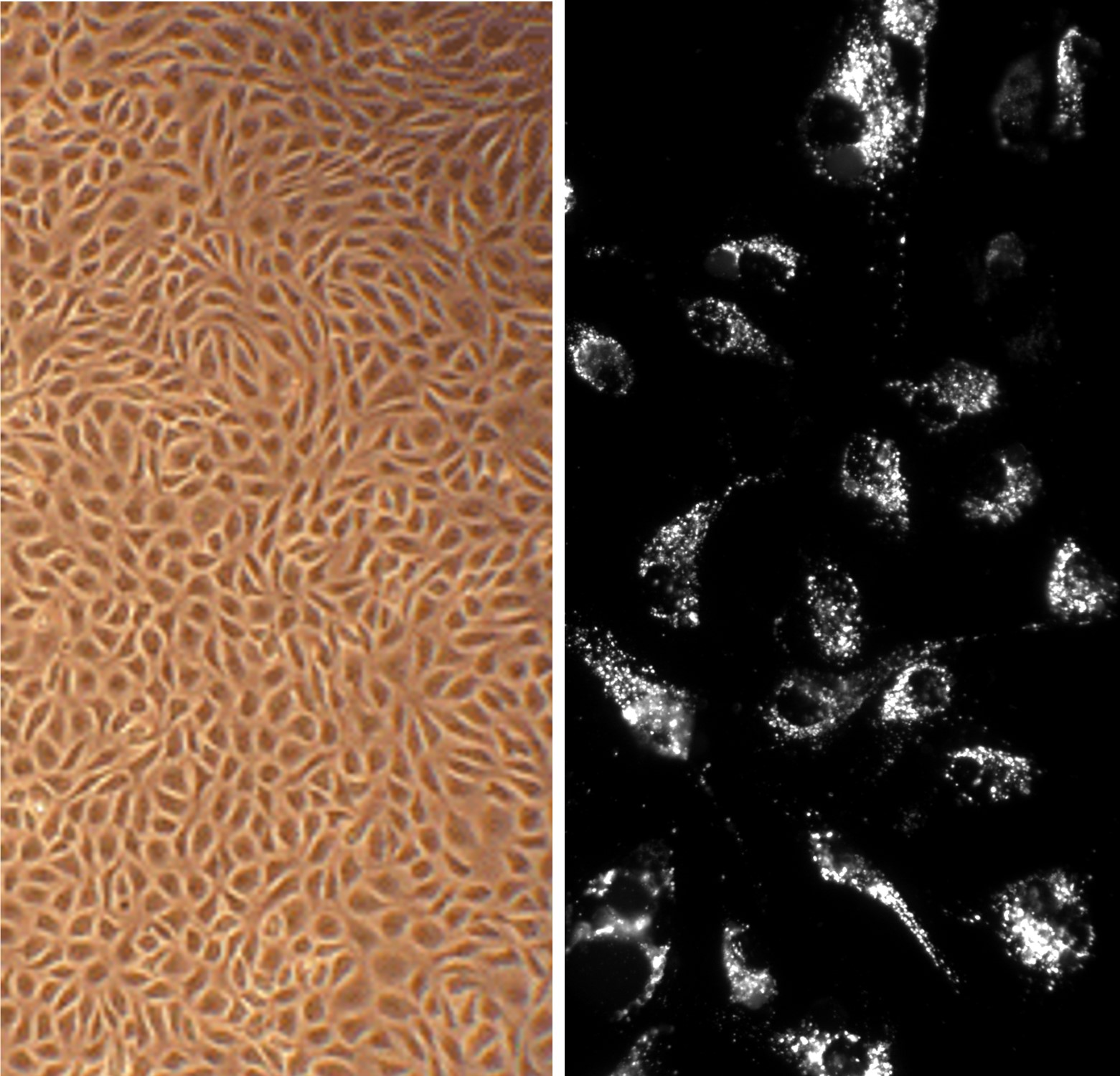Bovine Aortic Endothelial Cells: BAOEC
Description
Bovine aortic endothelial cells (BAOEC) provide an excellent model system to study all aspects of cardiovascular function and disease, such as critical signaling pathways and mechanisms relevant to proper function of endothelia, including angiogenesis, permeability, flow adaptation, NO production, and diabetes-related complications. BAOEC can also be used to search for beneficial modulators and delivery systems for therapeutic use, and to design scaffolds, surfaces and materials for tissue engineering and 3D modeling.
BAOEC from Cell Applications, Inc. have been used in dozens of research publications, for example to:
- Determine that simvastatin modulates beta-adrenergic signaling in vascular wall by inhibiting cAMP accumulation in response to epinephrine in a mechanism involving downregulation of Galpha(s) translation via Akt/mTOR/eIF4/4EBP pathway
- Elucidate the PKA-a signaling in endothelial cells by showing that it directly phosphorylates FoxO1 to regulate expression of VCAM-1
- Identify CaMKKβ and LKB1 as critical determinants of simvastatin-dependent activation of AMPK- and Rac1-modulated signaling and reveal that Rac1 in turn regulates LKB1 phosphorylation
- Demonstrate that Chondromodulin-I (ChM-I), a cartilage-derived angiogenesis inhibitor, impairs the VEGF-A-induced Rac1/Cdc42 activity leading to destabilized lamellipodial extensions and decreased motility of endothelial cells
- Demonstrate that cofilin-mediated actin alignment in the direction of shear stress is required for endothelial barrier integrity and that p190RhoGAP links integrins and caveolin-1/caveolae to RhoA in a mechanotransduction cascade that participates in endothelial adaptation to flow
- Show that activation of RhoA/ROCK/p38 MAPK pathway causes increased endothelial arginase activity/expression and is the key mediator of endothelial dysfunction and decreased NO production precipitated by either oxidative stress-activated PKC, or by angiotensin II-activated Gα12/13 G proteins coupled to AT1 receptors
- Demonstrate that activation of mTOR/p70S6K by angiotensin II may contribute to impairment of insulin-stimulated vasodilation through phosphorylation of IRS-1 at Ser636/639
- Discover that testosterone induces a non-genomic membrane-initiated Ca2+ dependent signaling pathway that leads to activation of NF-kB, providing an explanation for why men are predisposed to earlier onset of atherosclerosis
- Demonstrate that increase in salt concentration, observed in hypertension patients or in individuals with high salt intake, suppresses NO synthase activity, contributing to the development of hypertension
- Show that valsartan, a selective angiotensin II type 1 receptor (AT1R) blocker, increases NO production via Src/PI3K/Akt signaling that leads to phosphorylation of NO synthase
- Determine that long-chain polyunsaturated fatty acids exert their beneficial effects on cardiovascular health via activation of B2 receptor leading to elevated expression of NO synthase
- Show that transient receptor potential vanilloid type 1 (TRPV1) activation by evodiamine or capsaicin initiates two Ca2+-dependent signaling pathways, both resulting in activation of NO synthase: one is PI3K/Akt/CaMKII activation, which leads to NO synthase phosphorylation at Ser1179 and Ser635, and the other involves PP2B-dependent dephosphorylation of PKC leading to decreased phosphorylation of NO synthase at Thr497
- Discover that LDL-induced endothelial disfunction is mediated by epigenetic upregulation of p66shc promoter increasing expression of p66shc which then stimulates expression of ICAM-1 and inhibits expression of thrombomodulin, leading to stimulated adhesion of monocytes and to plasma coagulation on the surface of endothelial cells
- Elucidate the involvement of AMPK cascade and autophagy in mediating beneficial cardiovascular effects of green tea;
- Show, along with Bovine Brain Microvascular Endothelial Cells, also from Cell Applications, Inc., that brain microvasculature is more sensitive to pathogenesis, compared to large vessel endothelia, by demonstrating that C-reactive protein (CRP), a cardiovascular risk factor, induces higher oxidative stress in the brain microvasculature due to higher local expression of the CRP-receptors CD16, CD32 and of the NAD(P)H-oxidase subunit p22phox, and that brain microvascular endothelial cells show higher sensitivity to oxidative stress generated by advanced glycation end products due to stronger VEGF expression leading to increased permeability
- Improve the efficiency of small molecule cancer therapeutics by prolonging their cytoplasm stay
- Construct an expression cassette to maximize targeted transgene expression in large vessel endothelia, develop new viral-based vectors an evaluate apoA-I, IL-10 and NO synthase potential for for atheroprotective human gene therapy, and design scaffolds, surfaces and materials for tissue engineering and 3D modeling, as well as for therapies aimed to prevent stent thrombosis
- Show that erythropoietin (EPO)-mediated activation of NO synthase involves AMPK-dependent signaling, which leads to enhanced phosphorylation of βCR and NO synthase
Details
| Tissue | Healthy, normal aorta of USDA-inspected cattle | |
|---|---|---|
| QC | No bacteria, yeast, fungi, mycoplasma | |
| Character | DiI-Ac-LDL uptake: Positive | |
| Bioassay | Attach, spread, proliferate in Growth Med | |
| Cryopreserved | 500,000 BAOEC (2nd passage) frozen in Basal Medium w/ 10% FBS, 10% DMSO | |
| Kit | Cryovial frozen BAOEC (B304-05), Growth Medium (B211-500), Subculture Rgnt Kit (090K) | |
| Proliferating | Shipped in Gr Med, 3rd psg (flasks or plates) | |
| Doublings | At least 16 | |
| Applications | Laboratory research use only (RUO). Not for human, clinical, diagnostic or veterinary use. |
Resources
FAQs
Need More Help?
Visit our comprehensive FAQ page for detailed answers to common questions.
Need More Help?
Visit our comprehensive FAQ page for detailed answers to common questions.
Primary Cell FAQs